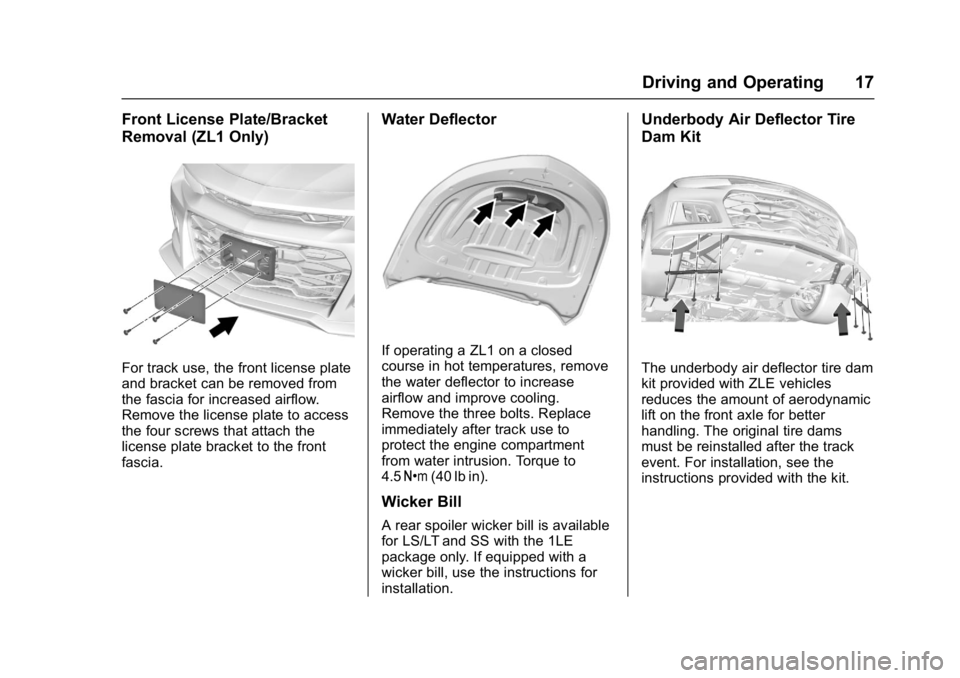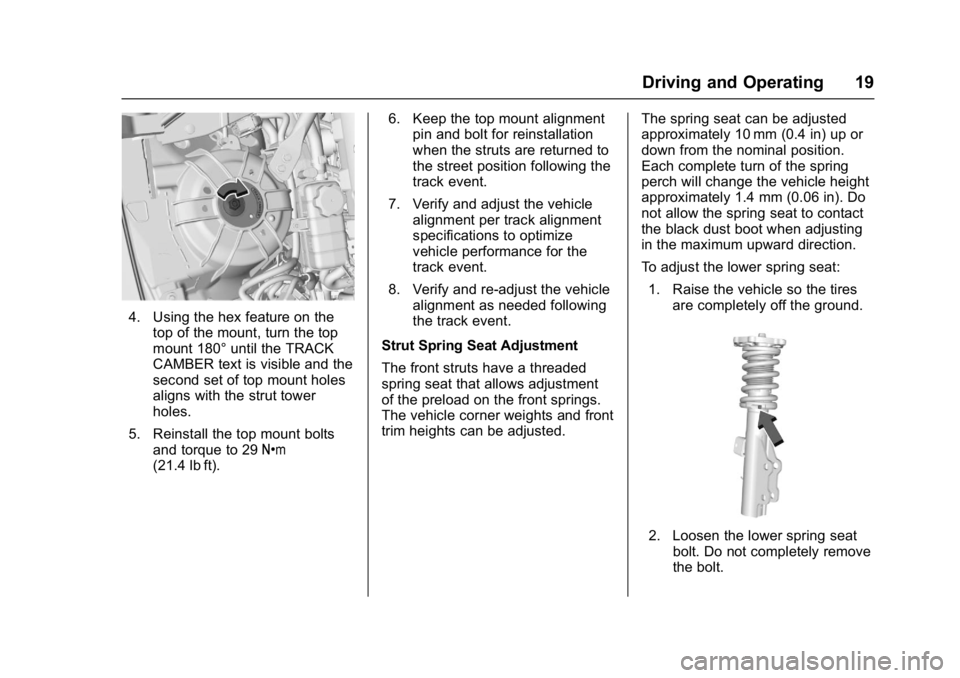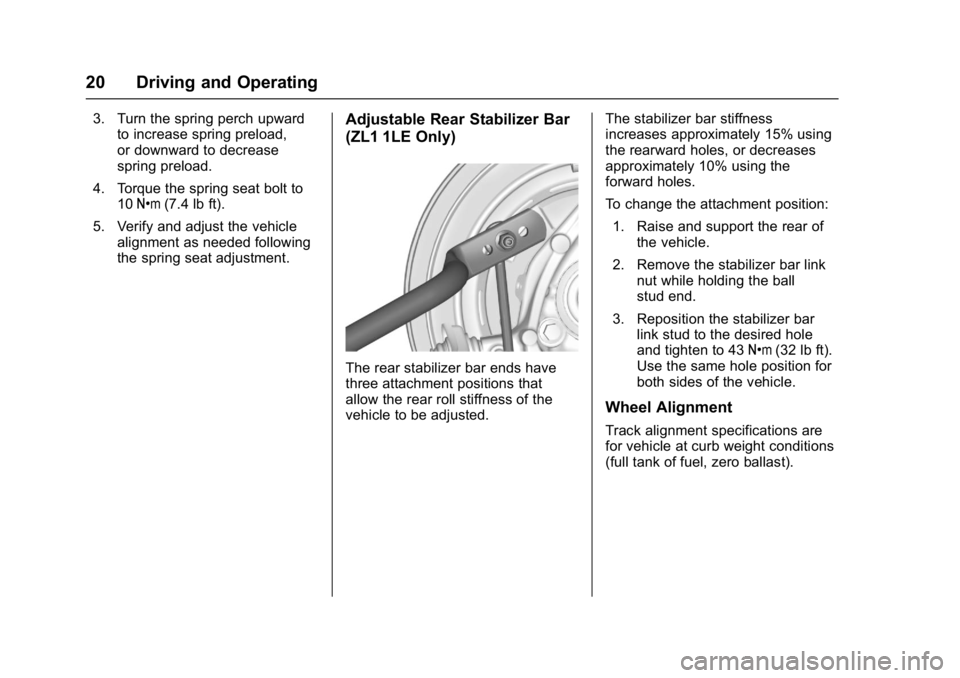Page 18 of 53

Chevrolet Camaro High Performance Owner Manual Supplemen (GMNA-
Localizing-U.S./Canada/Mexico-11348335) - 2018 - CRC - 4/5/17
Driving and Operating 17
Front License Plate/Bracket
Removal (ZL1 Only)
For track use, the front license plate
and bracket can be removed from
the fascia for increased airflow.
Remove the license plate to access
the four screws that attach the
license plate bracket to the front
fascia.
Water Deflector
If operating a ZL1 on a closed
course in hot temperatures, remove
the water deflector to increase
airflow and improve cooling.
Remove the three bolts. Replace
immediately after track use to
protect the engine compartment
from water intrusion. Torque to
4.5Y (40 lb in).
Wicker Bill
A rear spoiler wicker bill is available
for LS/LT and SS with the 1LE
package only. If equipped with a
wicker bill, use the instructions for
installation.
Underbody Air Deflector Tire
Dam Kit
The underbody air deflector tire dam
kit provided with ZLE vehicles
reduces the amount of aerodynamic
lift on the front axle for better
handling. The original tire dams
must be reinstalled after the track
event. For installation, see the
instructions provided with the kit.
Page 20 of 53

Chevrolet Camaro High Performance Owner Manual Supplemen (GMNA-
Localizing-U.S./Canada/Mexico-11348335) - 2018 - CRC - 4/5/17
Driving and Operating 19
4. Using the hex feature on thetop of the mount, turn the top
mount 180° until the TRACK
CAMBER text is visible and the
second set of top mount holes
aligns with the strut tower
holes.
5. Reinstall the top mount bolts and torque to 29 Y
(21.4 lb ft). 6. Keep the top mount alignment
pin and bolt for reinstallation
when the struts are returned to
the street position following the
track event.
7. Verify and adjust the vehicle alignment per track alignment
specifications to optimize
vehicle performance for the
track event.
8. Verify and re-adjust the vehicle alignment as needed following
the track event.
Strut Spring Seat Adjustment
The front struts have a threaded
spring seat that allows adjustment
of the preload on the front springs.
The vehicle corner weights and front
trim heights can be adjusted. The spring seat can be adjusted
approximately 10 mm (0.4 in) up or
down from the nominal position.
Each complete turn of the spring
perch will change the vehicle height
approximately 1.4 mm (0.06 in). Do
not allow the spring seat to contact
the black dust boot when adjusting
in the maximum upward direction.
To adjust the lower spring seat:
1. Raise the vehicle so the tires are completely off the ground.
2. Loosen the lower spring seatbolt. Do not completely remove
the bolt.
Page 21 of 53

Chevrolet Camaro High Performance Owner Manual Supplemen (GMNA-
Localizing-U.S./Canada/Mexico-11348335) - 2018 - CRC - 4/5/17
20 Driving and Operating
3. Turn the spring perch upwardto increase spring preload,
or downward to decrease
spring preload.
4. Torque the spring seat bolt to 10Y (7.4 lb ft).
5. Verify and adjust the vehicle alignment as needed following
the spring seat adjustment.Adjustable Rear Stabilizer Bar
(ZL1 1LE Only)
The rear stabilizer bar ends have
three attachment positions that
allow the rear roll stiffness of the
vehicle to be adjusted. The stabilizer bar stiffness
increases approximately 15% using
the rearward holes, or decreases
approximately 10% using the
forward holes.
To change the attachment position:
1. Raise and support the rear of the vehicle.
2. Remove the stabilizer bar link nut while holding the ball
stud end.
3. Reposition the stabilizer bar link stud to the desired hole
and tighten to 43 Y(32 lb ft).
Use the same hole position for
both sides of the vehicle.
Wheel Alignment
Track alignment specifications are
for vehicle at curb weight conditions
(full tank of fuel, zero ballast).
Page 27 of 53
Chevrolet Camaro High Performance Owner Manual Supplemen (GMNA-
Localizing-U.S./Canada/Mexico-11348335) - 2018 - CRC - 4/5/17
26 Driving and Operating
7. Release the brake pedal.
8. There are 15 seconds tocomplete the burnout and exit.
9. To release the brakes and roll out, press
1and SEL at the
same time. If the burnout is not completed in
15 seconds, torque will be reduced
to idle, the parking brake will be
applied, Line Lock releases, and
Custom Launch Control will be
disabled.
Ensure the parking brake is
disengaged to re-enter Launch
Control.
Automatic
Transmission
The Driver Information Center (DIC)
displays the current gear selected in
the lower right corner. When Sport
Mode is active, an S is displayed.
If Manual Mode is active, an M
displays next to the current gear
selected.
P :
This position locks the drive
wheels. It is the best position to use
when starting the engine because
the vehicle cannot move easily.
Page 33 of 53

Chevrolet Camaro High Performance Owner Manual Supplemen (GMNA-
Localizing-U.S./Canada/Mexico-11348335) - 2018 - CRC - 4/5/17
32 Driving and Operating
Limited-Slip Differential
The Electronic Limited-Slip
Differential (eLSD) is a hydraulically
actuated clutch system. It can
infinitely vary the clutch
engagement between 0 and 200
Yof breakaway torque between
the rear wheels. It responds to full
engagement within 0.150 seconds
when necessary. Smaller clutch
adjustments happen even faster.
The eLSD:
. Uses the vehicle sensors and
driver inputs to determine the
optimum amount of clutch
engagement for the conditions.
. Improves traction while
cornering by changing the
engagement to achieve a
balance between directional
control and acceleration.
. Provides optimal engagement
for high-speed control and
stability without affecting precise
steering and turn-in. .
Improves vehicle stability during
spirited driving and evasive
maneuvers. Is fully integrated
with the Active Handling and
Performance Traction
Management (PTM) systems.
There are unique calibrations based
on the Traction Control System
(TCS) setting. eLSD modes change
automatically when
Yis pressed.
No unique input from the driver is
required.
. Mode 1 is the standard mode
when the vehicle is started.
It provides a touring calibration
with an emphasis on vehicle
stability. Mode 1 is also used in
PTM Wet mode.
. Mode 2 is engaged when both
TCS and StabiliTrak are turned
off. This calibration provides
more nimble corner turn-in, and
is biased for better traction out of
corners. .
Mode 3 is engaged when PTM is
engaged in Dry, Sport 1 & 2, and
Race modes. This is a nimble
calibration with similar
functionality as eLSD Mode 2,
however, it is integrated to work
with PTM.
. Mode 4 is engaged when TCS is
selected off, but StabiliTrak
remains on. Vehicle stability is
still the priority, while allowing for
optimized traction out of corners.
The ZL1 coupe and SS 1LE are
calibrated uniquely and optimized
for their unique powertrain and
chassis combinations.
Page 49 of 53
Chevrolet Camaro High Performance Owner Manual Supplemen (GMNA-
Localizing-U.S./Canada/Mexico-11348335) - 2018 - CRC - 4/5/17
48 Technical Data
Engine Specifications
EngineVIN Code Transmission Spark Plug Gap Firing Order
6.2L V8 Engine (LT4) 6Automatic 0.725–0.875 mm
(0.029–0.034 in) 1–8–7–2–6–5–4–3
Engine Data
Engine
Horsepower TorqueDisplacement Compression Ratio
6.2L V8 Engine (LT4) 650650 lb ft 6.2L10.0:1